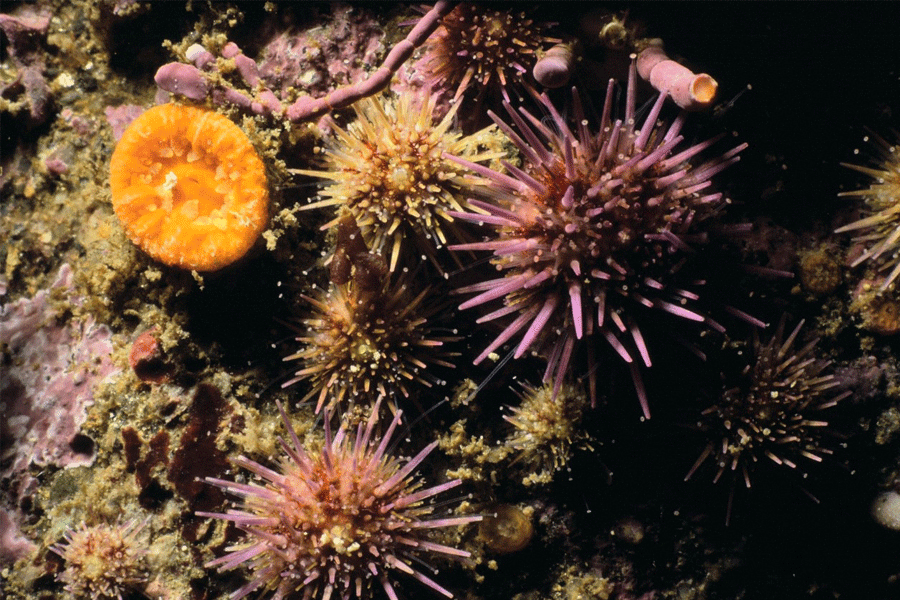
A team of researchers, led by a Florida State University biologist, has received a $1.1 million National Science Foundation grant to better understand how rapid and extreme warming events impact the reproduction of sea urchins.

Daniel Okamoto, an assistant professor in FSU’s Department of Biological Science and principal investigator for the grant, and his team will study population effects on sea urchins from such events as El Niño as well as the long-term implications from climate change. He said the impacts on California-based sea urchins from such events have been not only dramatic but also unpredictable.
“The grant is a follow-up to try to understand what’s really driving the patterns that we’ve seen over the past 30 years,” Okamoto said.
Okamoto will collaborate on the project with Jonathan Dennis, FSU associate professor of biology; Laura Rogers-Bennett, who holds positions at the California Department of Fish and Wildlife and the University of California, Davis; and Rachel Simons and Stephen Schroeter, both project scientists at the University of California, Santa Barbara.
Urchins are an ideal species for the study for a variety of reasons: They have immediate and noticeable responses to changes in temperature and food, their larvae feel the effects of changing ocean circulation because they float rather than settle, and they are a model developmental organism because the genome has been mapped.
In addition to the practical reasons for their study, sea urchins play an important role in near-shore ecosystems. Sea urchins are among the world’s major herbivores and are an important recycler of nutrients, but they can also be pests with the power to devour kelp forests.
“Climate change and extreme heat waves strongly affect sea urchin populations,” Okamoto said. “When their numbers explode, sea urchins can devastate ecosystems by eating everything in their path. In northern California, heat waves mean massive amounts of baby sea urchins. In southern California, it’s the opposite: Heat waves collapse the number of new young urchins.”
The NSF grant will be used decipher why warming events can lead to divergent outcomes for some populations. The study will focus on two primary factors: how temperature affects reproduction and how warming events affect ocean circulation.
Warmer water requires sea urchins to expend more energy just to stay alive, Okamoto said. That could mean less energy is available for females to produce eggs or the possibility for populations to “skip spawn” and not reproduce at all. Persistently warm water from a different geographic landscape in the south may be a culprit as well.
“Warm days aren’t going to kill a peach tree, but peach trees need a certain number of cold days to reproduce,” he said. “We think something similar could be happening with sea urchins.”
Heat also changes movement of ocean water. A change in ocean currents could impede the survival and delivery of free-floating urchin larvae to their near-shore ecosystems. The team will rely on oceanographic modeling led by UC Santa Barbara to characterize how ocean circulation patterns have changed over the past 30 years.
Okamoto said the NSF project will take advantage of data and urchin samples collected by researchers and students since 1990 from the California coast. He joined that collection effort as a graduate student at UC Santa Barbara in 2009, but the work was initially begun in the 1980s and ’90s by his collaborator Schroeter at UCSB, Tom Ebert at Oregon State University and others.
In September, Okamoto and others published a paper on the patterns found in the data in Limnology and Oceanography. The data collection is ongoing while the NSF grant supplies resources to help scientists understand why the patterns occur.
A component of the grant calls for working with K-12 students, in order to empower the next generation of scientists to think about the local consequences of climate change. FSU is distinctly prepared to carry out such a mission through its Office of STEM Teaching Activities outreach programs.
Barbara Shoplock, an FSU biologist and director of the OSTA’s Saturday-at-the-Sea programs, said she is looking forward to working with the researchers to help translate this Tier 1 research into formats most accessible for budding scientists.
Middle and high school students will take day trips to the FSU Coastal and Marine Laboratory and collect urchins in the Gulf of Mexico. They will be a part of monitoring how local populations are reacting to changing climate. That firsthand experience will help them see where their actions and personal choices can also be part of the solution, she said.
“Dr. Okamoto’s grant will enable us to bring more actionable science to these middle and high school students and allow them to become the ambassadors for awareness in their local communities,” Shoplock said. “That matters because now, more than any other time in human existence, we are aware of the fragile, interconnected nature of the world that we live in.”
The availability of resources like seafood are not guaranteed, Okamoto said. It’s critical to first understand how near-shore ecosystems respond to climate changes in order to find ways to ensure the future of those resources.




